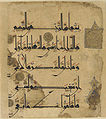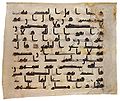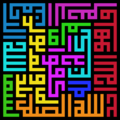- Kufic
-
Arab World 
This article is part of the series:
Arab Culture Drawing of an inscription of Basmala in Kufic script, 9th century. The original is in the Islamic Museum in Cairo (Inventar-Nr. 7853)
Drawing of an inscription of Basmala in Kufic script, 9th century. The original is in the Islamic Museum in Cairo (Inventar-Nr. 7853)
Kufic is the oldest calligraphic form of the various Arabic scripts and consists of a modified form of the old Nabataean script. Its name is derived from the city of Kufa, Iraq, although it was known in Mesopotamia at least 100 years before the foundation of Kufa. At the time of the emergence of Islam, this type of script was already in use in various parts of the Arabian Peninsula. It was in this script that the first copies of the Qur'an were written.
Contents
Characteristics
Kufic is a form of script consisting of straight lines and angles, often with elongated verticals and horizontals. It originally did not have consonant pointing distinguishing, for example, b, t, and th. It is still employed in Islamic countries though it has undergone a number of alterations over the years and also displays regional differences. The difference between the Kufic script used in the Arabian Peninsula and that employed in North African states is very marked.
Occurrence
Kufic was prevalent in manuscripts from the 8th-10th centuries.
Kufic is commonly seen on Seljuk coins and monuments and on early Ottoman coins. Its decorative character led to its use as a decorative element in several public and domestic buildings constructed prior to the Republican period in Turkey.
The current Flag of Iraq uses Kufic script to write اﷲ أكبر Allahu Akbar.
Western imitations
Main article: Pseudo-Kufic"Pseudo-Kufic", also "Kufesque", refers to imitations of the Kufic script, made in a non-Arabic context, during the Middle-Ages or the Renaissance: "Imitations of Arabic in European art are often described as pseudo-Kufic, borrowing the term for an Arabic script that emphasizes straight and angular strokes, and is most commonly used in Islamic architectural decoration".[1]
Gallery
-
Kufic script from an early Qur'an manuscript, 7th century.
-
Manuscript of the Surah al-Maryam of the Quran; Kufic script on gazelle skin, 9th c.
-
Kufic script, 8th or 9th century Quran
-
The flag of Iraq
-
The flag of Iran
See also
- Persian calligraphy
- Arabic calligraphy
- Bab Agnaou
Notes
- ^ Mack, p.51
References
- Mack, Rosamond E. Bazaar to Piazza: Islamic Trade and Italian Art, 1300–1600, University of California Press, 2001 ISBN 0520221311
External links
- Kufic alphabet http://www.fromoldbooks.org/Fry-Pantographia/pages/p004/
- On The Origins Of The Kufic Script
- Islamic Calligraphy Kufic & script types
- Kufic Script
- Square Kufic examples
- Square Kufic Script
- (Turkish) Traditional Turk-Islam Arts
- Kufic Encyclopedia
- Square Kufic
Arabic · العربية Overviews 
Alphabet Letters Eras Notable varieties Standardized: Modern Standard Arabic, Regional: Egyptian · Iraqi · Levantine · Maghrebi · Sudanese · Arabian · Judeo-ArabicAcademic Calligraphy
and scriptsLinguistics Phonology · Sun and moon letters · ʾIʿrāb (inflection) · Grammar · Triliteral root · Mater lectionis · IPA · Quranic Arabic CorpusCategories:- Arabic calligraphy
- Arabic script
-
Wikimedia Foundation. 2010.










